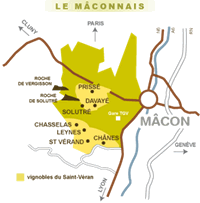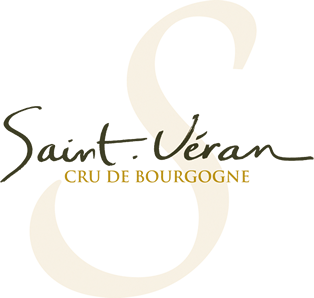AOC Location
 To the south of the Macon region, in the heart of Burgundy, the Saint Véran Appellation d'Origine Contrôlée enjoys an exceptional geographical location, sitting at the crossroads of three gastronomic regions – Burgundy, Beaujolais and Bresse.
To the south of the Macon region, in the heart of Burgundy, the Saint Véran Appellation d'Origine Contrôlée enjoys an exceptional geographical location, sitting at the crossroads of three gastronomic regions – Burgundy, Beaujolais and Bresse.
Saint-Véran wine has the distinction of being split into two distinct areas separated by the Pouilly-Fuissé vineyards (to the north, the districts of Davayé, Prissé and Solutré represent nearly 500 hectares and to the south, the districts of Chânes, Chasselas, Leynes and Saint-Vérand, around 200 hectares).
The two areas sit on each side of the Solutré range of hills.
The steep slopes on the western side are made up of grey marls (south-facing vineyards to the west of Chasselas and Leynes).
Gentle slopes dominated by marly limestone lay on the eastern side (east-facing vineyards of Prissé and Davayé).
On the left bank of the “Petite Grosne”, the vines are planted on limestone known as “à entroques” often covered by a layer of clay with “chailles”, a kind of flint (Châne and Prissé).
The characteristics of these rich, varied terroirs enable the single grape variety grown - the Chardonnay – to give its fullest expression.
This mosaic of terroirs results in a wide range of fresh, well-balanced wines, with a lovely golden colour that seems to reflect the sun.
Contact details:
Union des Producteurs du Cru Saint-Véran
Les Brosses
71960 Davayé
FRANCE
Tel. : +33 (0)3 85 35 85 07
Fax : +33 (0)9 81 38 17 06
Revenir en haut
History
The “Amicale des Producteurs de Vin Blanc” (association of white wine producers) was created in 1947. It brought together producers from the districts of Saint-Vérand, Leynes, Chasselas, Chânes and Saint-Amour who were producing white Beaujolais villages at the time.
The wine producers of Davayé, then those of Prissé, who were producing Mâcon villages white, joined the association in 1953 and 1969. The aim of the association was to compile the application for the creation of the appellation.
It was not until 6 January 1971 that the decree setting out the production regulations for the “Saint-Véran” Appellation Contrôlée was voted (published in the Official Journal of 10 January 1971).
Officially recognised as an “Organisme de Défense et de Gestion” (ODG), (protection and control organisation) by the INAO, the “Union des Producteurs du Cru Saint-Véran” (Union of Saint-Véran producers) is managed by a Board of Directors made up of 32 members, elected for 3 years at the producers’ annual general meeting.
Revenir en haut
Saint-Véran AOC key figures
697 hectares planted in 2010
7 producing districts:
Prissé, Davayé, Chasselas, Chânes, Leynes, Saint-Vérand
& Solutré-Pouilly
229 independent producers
157 cooperative growers
Divided into 6 cooperative wineries
“Vignerons des Terres Secrètes” in Prissé, Charnay les Mâcon, Chaintré, Igé, Juliénas, Vinzelles
40,283 hl produced in 2010 i.e. around 5.37 million bottles
of which 56.1 % produced by independent producers
and 43.9 % vinified by cooperative wineries (Vignerons des Terres Secrètes alone handles 85% of this production).
Revenir en haut
Saint-Véran Wines
Saint-Véran wines go wonderfully well with Bresse chicken in a cream sauce, veal stew, Brittany sea scallops or turbot in Hollandaise sauce.
Each Saint-Véran is a true reflection of each producer’s savoir-faire. A mysterious alchemy of man’s long labor and nature, it is the perfect alliance of the Chardonnay grape variety with the exceptional quality of the terroir and traditional vinification methods which give Saint-Véran its unique personality.
Saint-Véran wines display a fairly deep, bright gold colour. On the nose, the wine develops floral aromas blended with notes of white-fleshed fruit such as peach or pear. After a clean entry to the palate, the wine shows smooth substance with some fat and a fresh finish, all extremely well balanced.
In general, 3 types of Saint-Véran can be distinguished: those that develop a full, generous style of wine, i.e. terroirs such les Cras or les Monts; wines that are more mineral such as Saint-Véran la Mûre or En Faux; and finally, wines from the les Crèches or les Chailloux terroirs which stand out for their balance.
Sommelier’s recommendation:
Clean, clear cut and citrusy on entry, the wine demands dishes that can temper its ardour. Creamy-fleshed fish, poached or simply pan-fried, is a perfect match, especially as the wine’s mineral touch and floral aromatic range will really complement the iodine and fine flesh of the fish. Any seafood-based dish will also go very nicely, as will risottos with seafood or mushrooms, the soft texture of which will be nicely framed by the wine’s strong lemony character. It also pairs well with goat’s cheese, Bleu de Bresse, Comté, Beaufort and Gruyère cheeses.
Serving temperatures:
9 to 11 °C for a young wine,
11 à 13 °C for an older wine.
Revenir en haut
Latest news from the Saint-Véran A.O.C.
Saint-Véran is seeking premiers crus (first growths) recognition. The Saint-Véran producers had been contemplating having a Saint-Véran premier cru alongside their village appellation for some time…
Currently, none of appellations in the Mâcon region benefit from premiers crus recognition. This is for historical reasons. This Southern Burgundy area did not receive any classification as premier cru following the creation of the AOCs in 1936. This was because the region was located south of the demarcation line, in Free France, during the Occupation. North of the demarcation line, the German army had been instructed to requisition for its troops all the wines that were not premiers crus. To protect themselves many villages and appellations north of the line quickly had a great number of small local areas classified as premiers crus.
Application preparation
A study of the terroirs in the appellation area was performed between 2006 and 2008 by a specialized firm (SIGALES) enabling the precise characteristics of each local vineyard area to be identified.
On 3 March 2010, the Saint-Véran appellation officially submitted the first draft of its application for recognition of its premiers crus at the INAO offices in Mâcon. Since then, the AOC’s producers have been fine-tuning and completing the application.
Since 2008, numerous blind tasting have been carried out of wine from each of the appellation’s local vineyard areas, over various vintages. Tastings will continue in 2012. These will result in each vineyard area receiving a tasting score.
In parallel, the ODG has, with the help of the wine producers, sorted and catalogued all press coverage and medals etc, which are regularly received, by each local vineyard area. Here again, this work enabled us to score each local vineyard area.
The commission is therefore working on various different action points. A final score will be awarded enabling the most promising local vineyard areas to be pinpointed.
This work will then be submitted to a commission of inquiry who will study each local vineyard area.
In short, there is still much work to be done and some time before first Saint Véran premiers crus see the light of day, but the producers are very motivated and working flat out to ensure the success of their endeavour.
Revenir en haut
 To the south of the Macon region, in the heart of Burgundy, the Saint Véran Appellation d'Origine Contrôlée enjoys an exceptional geographical location, sitting at the crossroads of three gastronomic regions – Burgundy, Beaujolais and Bresse.
To the south of the Macon region, in the heart of Burgundy, the Saint Véran Appellation d'Origine Contrôlée enjoys an exceptional geographical location, sitting at the crossroads of three gastronomic regions – Burgundy, Beaujolais and Bresse.
